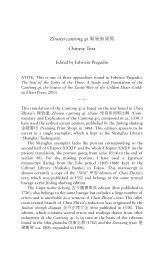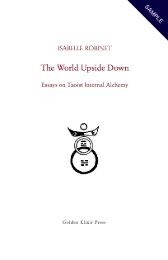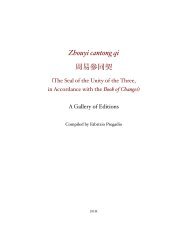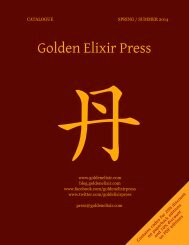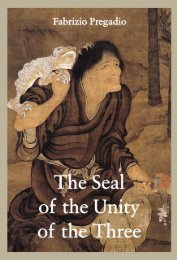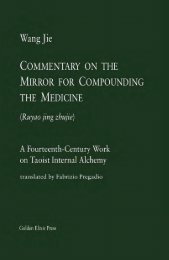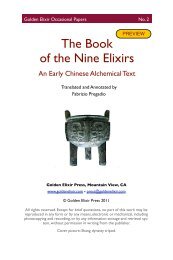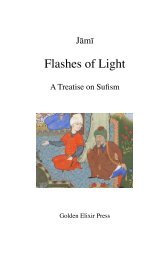The Seal of the Unity of the Three â Vol. 2 - The Golden Elixir
The Seal of the Unity of the Three â Vol. 2 - The Golden Elixir
The Seal of the Unity of the Three â Vol. 2 - The Golden Elixir
- No tags were found...
You also want an ePaper? Increase the reach of your titles
YUMPU automatically turns print PDFs into web optimized ePapers that Google loves.
Introduction 7<br />
—————————————————————————————————————————<br />
61 Comm. Dong Dening (1787) [29]<br />
62 Comm. Jiang Zhongzhen (1694) [21]<br />
63 Comm. Ji Dakui (1797) [30]<br />
65 Comm. Liu Yiming (1799) [31]<br />
66 Comm. Li Shixu (1823) [32]<br />
69 Comm. Lü Huilian (1879) [33]<br />
Shorter studies <strong>of</strong> editions <strong>of</strong> <strong>the</strong> Cantong qi include those by Meng<br />
Naichang 孟 乃 昌 , “Zhouyi cantong qi de zhulu yu banben” 『 周 易 参 同<br />
契 』 的 著 录 与 版 本 (Bibliographic records and editions <strong>of</strong> <strong>the</strong> Zhouyi<br />
cantong qi, 1988); and by Pan Yanchuan 潘 延 川 , “Shixi Cantong qi de<br />
zhushi banben” 析 『 参 同 契 』 的 注 版 本 (A preliminary analysis <strong>of</strong><br />
editions <strong>of</strong> commentaries to <strong>the</strong> Cantong qi, 1988).<br />
MODERN ANNOTATED EDITIONS<br />
Transcriptions <strong>of</strong> <strong>the</strong> Cantong qi with annotations and explications<br />
have been published by several authors. All <strong>of</strong> <strong>the</strong>m read <strong>the</strong> text as<br />
concerned with Neidan (Internal Alchemy). Only a few <strong>of</strong> <strong>the</strong> more<br />
valuable works will be cited here.<br />
(1) Chen Yingning’s 陳 攖 寧 (1880–1969) Cantong qi jiangyi 『 參<br />
同 契 』 講 義 (An Explication <strong>of</strong> <strong>the</strong> Meaning <strong>of</strong> <strong>the</strong> Cantong qi) may<br />
be deemed to be <strong>the</strong> first work belonging to this group. <strong>The</strong> text is<br />
based on Lu Xixing’s Zhouyi cantong qi ceshu, and <strong>the</strong> notes frequently<br />
quote <strong>the</strong> commentaries by Lu Xixing, Tao Susi, and Qiu<br />
Zhao’ao. 8<br />
(2) Fang Xu’s 方 煦 “Zhouyi cantong qi jiangjie” 周 易 參 同 契 講 解<br />
(An explication <strong>of</strong> <strong>the</strong> Zhouyi cantong qi), published in 1988, is based<br />
on <strong>the</strong> Daozang edition <strong>of</strong> Peng Xiao’s redaction, rearranged into<br />
three main parts and 35 sections. Each section is followed by a general<br />
explication and notes on individual verses or terms.<br />
(3) Wu Enpu’s 烏 恩 浦 “Zhouyi cantong qi”, published in 1992, is<br />
based on <strong>the</strong> text established by Zhu Yuanyu, and accordingly is<br />
divided into three parts and 36 sections. In addition to <strong>the</strong> main text,<br />
each section contains a general explication, notes on verses and terms,<br />
and, interestingly, a poetical paraphrase into seven-character verses.<br />
8<br />
On Chen Yingning see Qing Xitai, Zhongguo Daojiao shi, 4:375–415;<br />
and Ca<strong>the</strong>rine Despeux’s entry in Pregadio, ed., <strong>The</strong> Encyclopedia <strong>of</strong> Taoism,<br />
1:261. <strong>The</strong>re are several editions <strong>of</strong> Chen’s work, including one found in Hu<br />
Haiya and Wu Guozong, eds., Zhonghua xianxue yangsheng quanshu, vol. 1.<br />
Visit <strong>the</strong> Web page on this book • www.goldenelixir.com



